VVAM Newsletter 92 – 2004
FRIENDS OF THE AIRBORNE MUSEUM
Editors:
Drs. R.P.G.A. Voskuil
C. van Roekel
G.H. Maassen jr.
Newsletter No. 92, December 2003
Translated by Cathrien and Peter Clark
Representative in Great Britain: Niall Cherry, 3 Church Road, Warton, Lancs, PR4 1BD Tel. home 0177-2632764
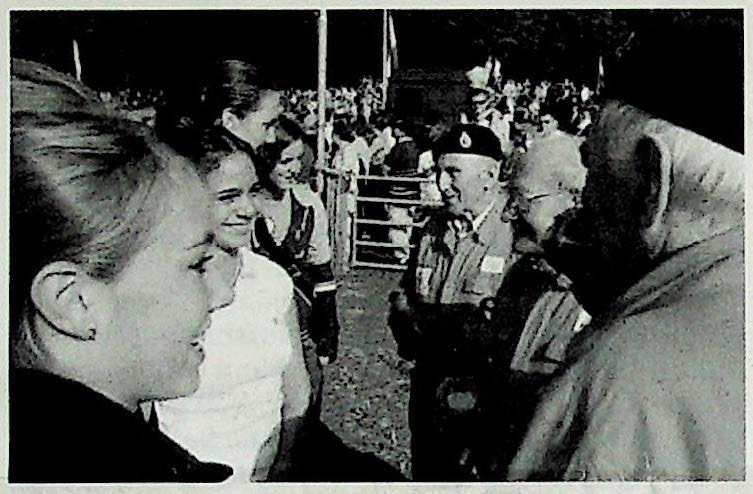 20 September 2003. After their parachute jump on Ginkel Heath, British veterans chat with Dutch schoolchildren.
20 September 2003. After their parachute jump on Ginkel Heath, British veterans chat with Dutch schoolchildren.
(photo: Berry de Reus)
Social Evening
The Airborne Museum will be holding a Social Evening for members of the society on 13 February 2004, commencing at 19.30 hours.
A number of members will be bringing along items from their personal collections for exhibition, the store and restoration rooms will be open, as will the library and archives.
And of course, there will be plenty of opportunity to exchange views on the multitude of subjects connected with Operation ‘Market Garden’.
AGM
The 24th AGM will be held in the Concert Hall in Oosterbeek on Saturday morning 3 April 2004, in conjunction with the General Members’ Meeting of the Society of Friends of the Airborne Museum. Lunch will be available after the meeting, and there will be an excursion in the afternoon.
Further details will appear in the next issue of the Newsletter.
Battlefield tours 2004
A large number of battlefield tours are scheduled for 2004.
First off is an excursion to Normandy, from Wednesday 19 until Sunday 23 May 2004 inclusive, organised by the Airborne Museum. The cost is € 495, based on shared double rooms. Contact the museum for a programme overview and further information.
Then in June we begin a repeat of the entire series of Market Garden tours, tour dates being:
12 June, Market Garden ‘T: South Netherlands;
3 July, Market Garden ‘2’: Central Netherlands;
21 August, Market Garden ‘3’: Betuwe; and
11 September, Market Garden ‘4’: Arnhem and Oosterbeek. The cost for SFAM members is € 30 per tour, € 32 for non-members. Anyone booking for three tours at the same time will receive a free Holt’s battlefield map of the Operation Market Garden area. A battlefield tour to the Ardennes is being organised for 7 to 10 October 2004 inclusive. The programme is not yet finalised but will cover such events as: the fighting in and around Bastogne, the advance of Kampfgruppe Peiper, and the battles of E Company, 506th Regiment, 101st American Airborne Division (‘Band of Brothers’). Visits to three local museums are included in the excursion. It may also be possible to arrange a visit to fort Eben Emael. Cost per person is € 395 all in.
A programme overview and further information on/for this excursion can also be obtained from the Airborne Museum, or visit our website, www.airbornemuseum.com.
(W. Boersma)
Action for RAF Monument
In Newsletter number 90 we mentioned the initiative of member Philip Reinders for the raising of a monument to the aircrews of the Royal Air Force. Although they were not part of the 1st British Airborne Division, the men of the RAF played a vital role in September 1944. From the 17th up to and including the 25th they flew numerous missions, towing gliders to the landing zones and then transporting supplies to the beleaguered troops in Oosterbeek. 153 airmen lost their lives, and many were wounded during these re-supply flights, which were often unescorted and always flown at low altitude. Despite the heavy losses, enemy fighters and Flak, several runs were sometimes made across the dropping zones to make sure that all the panniers and containers had been dropped, the crews being unaware that most of the supply dropping zones were in German hands.
Various (former) airfields in England have monuments to these courageous crews, but in Arnhem and Oosterbeek there are no memorials where veterans or relatives of RAF aircrews can pause for a few moments and reflect in silence on what happened here nearly 60 years ago. Hopefully this oversight will be rectified in 2004, sixty years after the Battle of Arnhem. As already mentioned, a location has been found where the new monument will be placed. It is in the grounds of the Rehoboth School in Johanniterweg, Doorwerth. Stirling LJ-928 from 196 Squadron crashed there on 21 September 1944 with the loss of all on board. Following discussions with the head teacher and the school governors it was decided to raise a memorial on the site, not just to the crew of LJ-928 but to all RAF airmen who took part in the hazardous missions to Oosterbeek between 17 and 26 September 1944. The cost for producing a simple stone pillar with explanatory text is about € 2000, and although collections have already been made we are still somewhat short of the full amount. Therefore an action has been started whereby people who would like to see the setting up of this RAF monument are kindly asked if they would care to make a financial donation. A special bank account has been opened for this purpose.
New monument at the Rhine
A monument to the allied soldiers who managed to withdraw across the river Rhine during the night of 25/26 September 1944 in operation ‘Berlin’, was unveiled on Sunday afternoon 21 September last. The new memorial is close to the north bank of the Rhine, on the flood plains behind the Old Church in Oosterbeek. Rob van der Zon, from Oosterbeek, instigated the project together with some friends, including Friends’ Society member Axe Jon Versluijs. The group also financed the monument which was designed and made by Rob van der Zon. The unveiling ceremony was carried out by ex-Sgt. M.J. Potter, one of the men who managed to escape across the Rhine 59 years ago. Sgt. Potter, Royal Engineers, was the man who took a small bulldozer to Arnhem by Horsa glider in September 1944. The bulldozer eventually ended up at Sonnenberg in Oosterbeek.
After the unveiling, which was attended by sixty veterans and about a hundred others, a group of thirty swimmers swam the Rhine, a tradition dating from 1998.
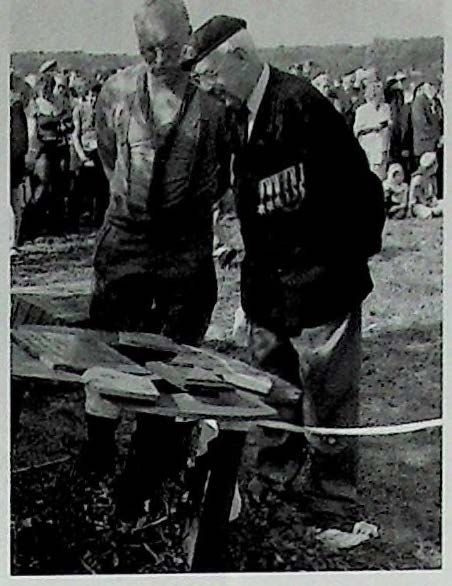 21 September 2003. Following its unveiling, Rob van der Zon – who fashioned the monument – and veteran Mr. M. J. Potter inspect the new Operation Berlin monument on the flood plains of the Rhine at Oosterbeek. (photo: Axe Jon Versluijs)
21 September 2003. Following its unveiling, Rob van der Zon – who fashioned the monument – and veteran Mr. M. J. Potter inspect the new Operation Berlin monument on the flood plains of the Rhine at Oosterbeek. (photo: Axe Jon Versluijs)
Gift of medal sets
Over the past months the Airborne Museum has received medal sets that belonged to the following people: Captain, the Reverend, R.F. Bowers, in 1944 padre/army chaplain, 10th Parachute Battalion; Trooper R. McSkimmings, Reconnaissance Squadron, who died on 19 September 1944; Lance Corporal Harold E. Back of the 2nd Parachute Battalion; and Private E.V.B. Mordecai, Royal Army Ordnance Corps.
(Roland Boekhorst)
News from Niall
Niall Cherry, our UK rep., has sent us some additional information about one of the photos taken on 20 September 1944 in Utrechtseweg, Oosterbeek, by a German war photographer (Jacobsen, ed.).
The photo, printed here, shows Gunner Eric Milner, C Troop, 1st Airlanding Anti-Tank Battery, Royal Artillery, (right), being searched by a German soldier in the garden of the Berghege family home, opposite Annastraat. (This house was badly damaged during lhe battle but repaired after the war. It was demolished later, and the ABN/AMRO bank was built on the site).
Not long ago Eric Milner told Niall that the photograph was taken just as the German soldier had taken a packet of chewing gum from Eric’s pocket. Horrified, Eric thought for a second that the German was going to pop the chewing gum into his mouth, but luckily he didn’t. He returned the packet, not knowing that it concealed an escape saw!
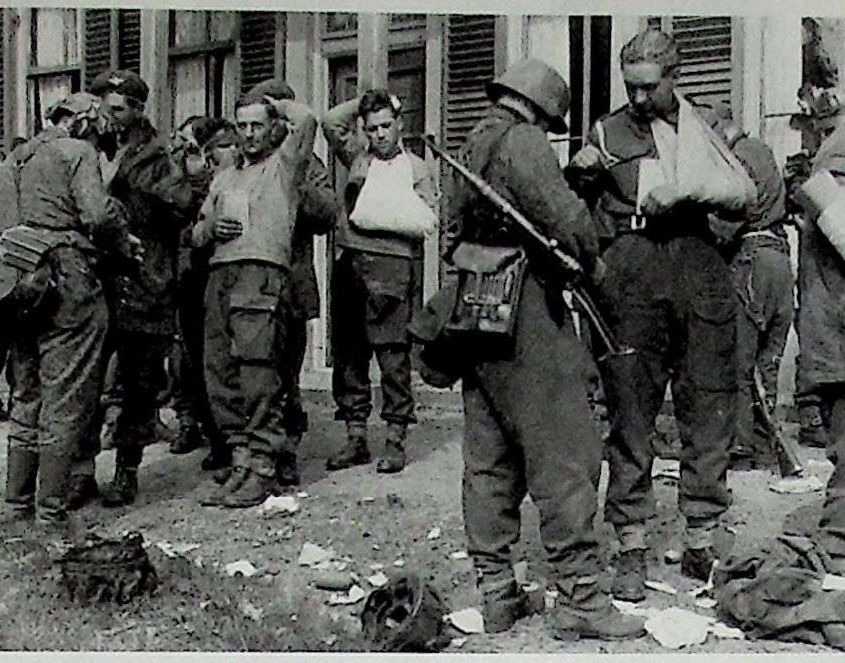 C Troop 1st AT Bty, commanded by Lieutenant Ted Shaw (later, for many years our SFAM representative 20 September 2944. German soldiers search British wounded in front of the house of the Berghege family in Utrechtseweg, opposite Annastraat, in Oosterbeek. Right, with an arm in a sling, Eric Milner.
C Troop 1st AT Bty, commanded by Lieutenant Ted Shaw (later, for many years our SFAM representative 20 September 2944. German soldiers search British wounded in front of the house of the Berghege family in Utrechtseweg, opposite Annastraat, in Oosterbeek. Right, with an arm in a sling, Eric Milner.
(photo: Bundesarchiv, Koblenz)
in Britain!), had provided 3rd Parachute Battalion with artillery support over the previous days in Arnhem. Eric was wounded on 19 September during the withdrawal from Arnhem to Oosterbeek. He arrived at the emergency hospital in the Schoonoord Hotel but things were so hectic there that he was passed on to a 133rd Parachute Field Ambulance first-aid post in houses east of the Vreewijk Hotel, at that time in German hands.
Eric was going into the Berghege house via the back door when he was stopped by a Royal Army Medical Corps corporal. Angrily, the medic asked Eric if he wanted to see everyone in the house shot by the Germans, because he was about to enter a first-aid post while still armed with a rifle! There were two Germans and a number of British wounded at the front of the house. Eric’s arm was dressed, and shortly afterwards the photo in question was taken.
Next day he managed to escape and rejoined his gun crew. However, he was recaptured on 24 September 1944.
Fred Bolle, the BID and Veerweg
On 1 October 2003, Warrant Officer Instructor Fred Bolle took early retirement from the army. During his army career he served for many years with the ‘Bergings en Identificatie Dienst’of the ‘Koninklijke Landmacht’ (BID – Recovery and Identification Unit, Royal Netherlands Army), lastly as commander of the unit in succession to Captain H.J.R. Jongen.
He was involved many times in the exhumation and identification of the remains of servicemen killed in the Second World War.
In April of this year his job brought him to Oosterbeek again. The remains of a British serviceman were discovered during excavation work in a garden in Veerweg (very close to the Westerbouwing). Thirty mortar bombs and two hand grenades of British make were unearthed at the same time. These were destroyed near Doorwerth Castle by the EOD KL (‘Explosieven Opruimings Dienst, Koninklijke Landmacht’ – Dutch Army Bomb Disposal Unit).
Warrant Officer Bolle and his colleague Sergeant Major Geert Jonker were able to recover almost the entire skeleton. There was a four-centimetre hole in the skull, probably caused by shrapnel. Other remarkable finds included two Airborne helmets (1942, first pattern), one pair of ‘ankle boots’, a triangular neckerchief (cut from parachute material), remains of a leather wallet (including a devotional picture among its contents), a sprig of dried heather, a small crucifix and scraps of paper bearing illegible writing.
Investigation by the BID, in which the recovered dental items played a major part, led to a rapid positive identification. The findings were sent to the relevant authorities (such as the British Embassy and the Ministry of Defence in the UK) who, after certain verifications, would confirm the identity of the serviceman.
There was well-founded hope that the Airborne soldier concerned would find his last resting place among his comrades in the Arnhem (Oosterbeek) War Cemetery during last September’s commemorations of the Battle of Arnhem. But as usual in such cases, the British machinery grinds slow. Alas, that means that at the time of writing (5 December 2003), the identity of this soldier has still not been made known. On top of that his remains have not yet been buried in the Airborne Cemetery in Oosterbeek. Sadly enough, they are still being kept at the BID in Bussum, as they have been for the last eight months.
By Land, Sea and Air
Much remains to be told about the Battle of Arnhem, a fact once more emphasised by the appearance of ‘By Land, Sea and Air’, a book about the 2nd Battalion, The South Staffordshire Regiment. It is written in English by Alexander Junier and Bart Smulders, assisted by Jaap Korsloot. All three are Friends of the Airborne Museum.
The South Staffordshire battalion was one of the nine British combat battalions in the battle, and earned its own place in history, not least through winning two Victoria Crosses. This aptly named book tells all.
The 80th Regiment of Foot, ‘Staffordshire volunteers’, was formed in 1783. In 1881 it was renamed the ‘2nd Battalion The South Staffordshire Regiment (80th Foot)’, and in 1941 the infantry battalion, already with a colourful past behind it, was attached to the newly formed 1st British Airborne Division as an airlanding unit. It trained hard for its airborne role, the landing by glider behind enemy lines. We follow the battalion to North Africa in 1943, where it prepares for the invasion of Sicily. In this operation the gliders of a large part of the battalion are released well short of the coast and land in the sea. Many Staffords are drowned.
We witness the fighting for the Ponte Grande bridge and Syracuse. Five days later 288 of the 816 men return to Tunisia. So the battalion had been to war by land, sea and air. We follow the battalion to Italy, where it is deployed in places such as Foggia and Brindisi in order to occupy towns and villages in the fighting there.
On 17 September 1944 the bulk of the battalion lands at Wolfheze. The most important tasks are the holding of landing zone S for the second lift on the 18th, and the crossroads north of Wolfheze. Instead it is rushed to Arnhem to reinforce the 1st, 2nd and 3rd Parachute Battalions already fighting there. Due to a shortage of aircraft the rest of the battalion lands the following day. This group is also hurried off to Arnhem.
On 19 September the battalion leads the attempt to push along Utrechtseweg to the centre of Arnhem, where the 1st Parachute Battalion has been held up. After fierce fighting it withdraws to Lower Oosterbeek where it is deployed to defend the eastern side of the perimeter foot. We experience the fighting in which the Germans struggle to cut the British division off from the Rhine, right up to its withdrawal on the night of the 25th. They almost succeed. It is there that Major R.H. Cain and Sergeant J.D. Baskeyfield win their Victoria Crosses.
Being closest to the Rhine the Staffords are among the last to leave, so many are left behind on the north bank when the last evacuation boat has gone, and are taken prisoner. Only 25% of the battalion makes it back across the river.
In various appendices we follow the experiences of 12 Platoon, which lands near Tilburg, and of the Staffords who are taken to POW camps in Poland and Germany after Arnhem. In the spring of 1945 the battalion forms part of the Army of Liberation in Oslo, Norway.
The authors have researched their subject very thoroughly, with excellent results. Admirable. The personal stories of the men bring history to life, and therefore enthralling. One feels close to events, and the reader can almost experience the battle.
The book was presented on 22 November 2003, and, as we have come to expect, is beautifully produced by Robert N. Sigmond Publishing. It contains many illustrations, good maps, and reads easily. ‘By Land, Sea and Air, An Illustrated History of the 2nd Battalion The South Staffordshire Regiment 1940-1945. From Official Records and Personal Accounts of Members of the Battalion’ is in English, comprises 224 pages, and costs € 27,50. It is available from the Airborne Museum ‘Hartenstein’ in Oosterbeek and the Gelders Archief in Arnhem, and from (local) bookshops (ISBN 90-804718-6-0).
(Okko Luursema)
CD-Rom of communications lecture
On Saturday 22 November 2003, Wybo Boersma gave a fascinating lecture in the Concert Hall in Oosterbeek on the communications systems as used by the 1st British Airborne Division during the Battle of Arnhem. The talk covered all the resources used, such as the various radio transmitters/receivers, radar equipment, field telephones, and even carrier pigeons. Wybo gave the lecture using a PowerPoint computer presentation containing layouts, drawings, maps and photographs.
The complete presentation is available on CD-Rom, now on sale at the Airborne Museum for € 5. Copies can also be ordered from W. Boersma. If sent by post the CD-Rom costs € 7.50.
Postage stamps sought
‘Every cloud has a silver lining’, says ex-footballer Johan Cruijff. Thus, when 1 stepped down as chairman of the Friends’ Society, I suddenly had more time to return to one of my hobbies that had been pushed into the background.
For many years I have been putting together a postage stamp collection which reflects the rise and fall of National Socialism. Therefore, they are principally German stamps from the 1932-1945 period, but come as well from other regions involved in World War II.
Because no albums on tills theme exist, I have spent several months compiling a book in which, based on postage stamps, this period is described. Modem scanner and printing techniques, and of course the acquired leisure time, enable me to do this.
My request to you is, could you possibly check to see if you have anything that could add to my collection, and which you are prepared to make available to me? And who knows, in due course I could even surprise you with a small exhibition on the subject.
I can be contacted at my address: Benedendorpsweg 119, 6882 WE Oosterbeek, telephone 026 3333261, or by e-mail: chris.van.roekel@l2move.nl.
Thanking you in anticipation, Chris van Roekel.

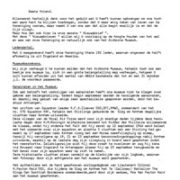
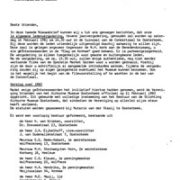
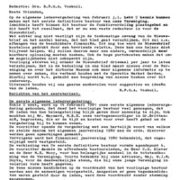
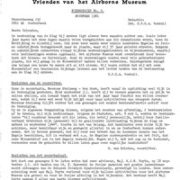
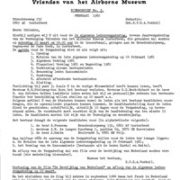
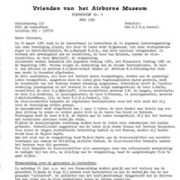
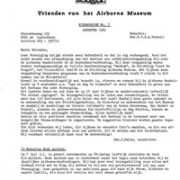
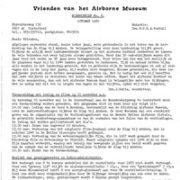
Plaats een Reactie
Vraag of reactie?Laat hier uw reactie achter.